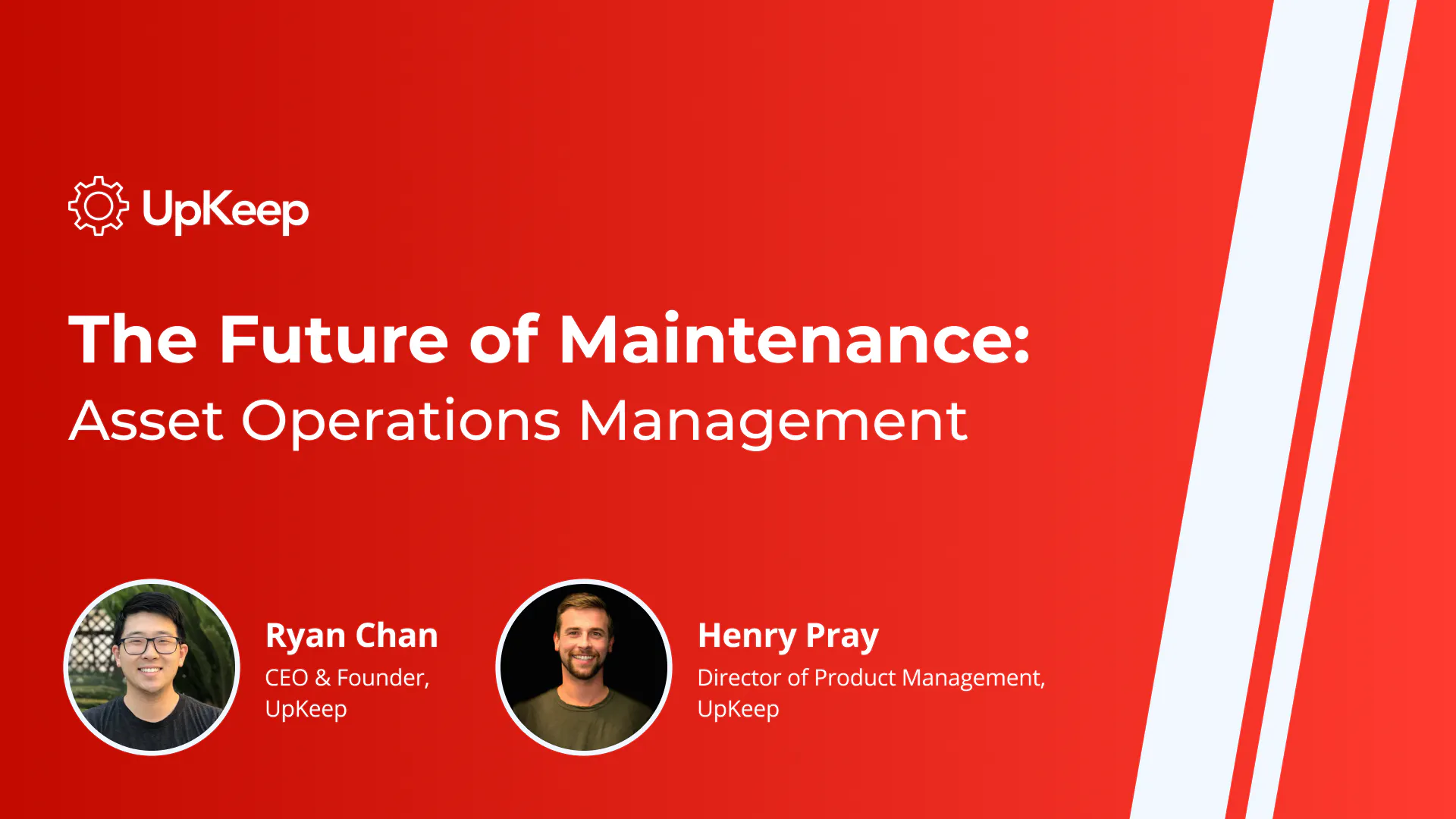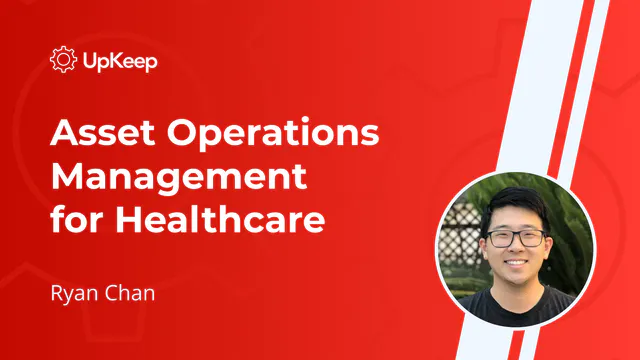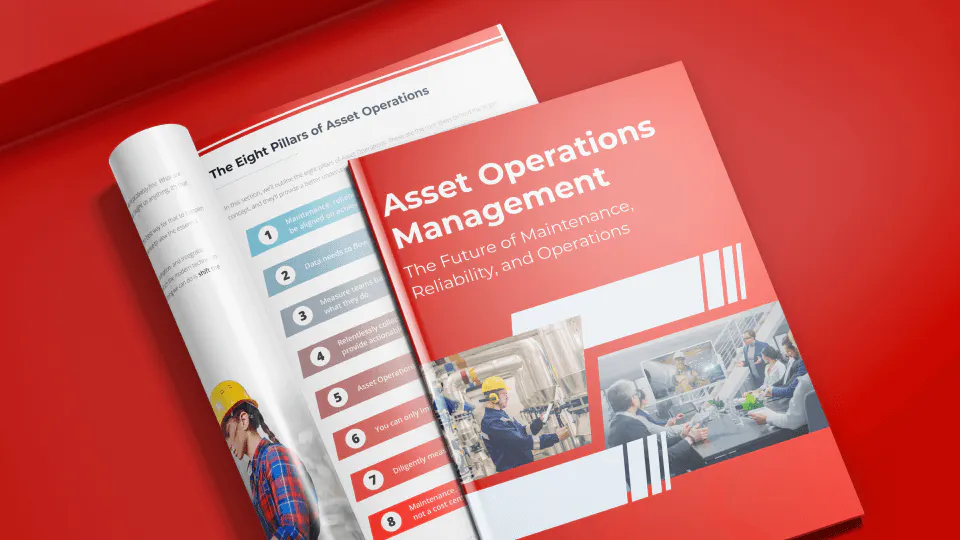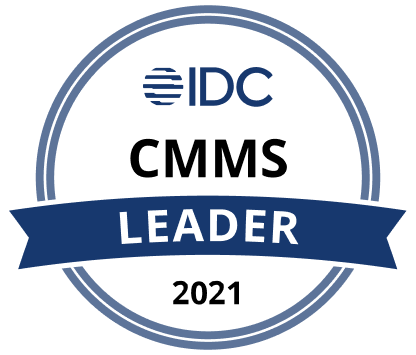What Is Asset Operations Management?
Asset Operations Management threads together an organization’s technician services, passive and active data, and unique operational blueprint to make it easier and faster for every employee to get what they need to do their jobs successfully.


On-Demand Webinar
The Future of Maintenance: Asset Operations Management
Uniquely positioned to tackle industry challenges, UpKeep brings maintenance, reliability, and operations teams together in a new approach called Asset Operations Management.

On-Demand Webinar
Asset Operations Management for Healthcare
Join UpKeep CEO and Founder, Ryan Chan, to gain a deeper understanding of what the healthcare industry is facing—from regulatory oversight to managing an increasing number of connected devices.

Whitepaper
Asset Operations Management: The Future of Maintenance, Reliability, and Operations
How Did We Get Here?
Today, asset-intensive companies are divided. Despite having access to more technical data and tools than ever before, these organizations find themselves at a crossroads: continue working in inefficient and misaligned data silos, or work holistically toward the same goal by leveraging technology advances and a new mindset.
Unfortunately, many companies are traveling down the first path, which led us to ask, “Why is that, and what can we do about it?” Based on market trends we’ve seen in internal deals as well as from industry publications and analysts, we uncovered three, major hurdles.
Software Doesn’t Address Worker Needs
Modern maintenance, reliability, and operations teams need technology that works the way they work—in the field, with simple UI, and built for mobile. However, most software systems are still desktop-based, even though their end users never sit in front of a desk. This makes it difficult for teams to perform their best work because they’re tied to software that’s disjointed, outdated, and hard to use.
Companies Aren’t Utilizing Technological Advances
In recent years, data has become prolific, ushering in an intelligence revolution. Organizations can leverage active and passive data from both humans and sensors to monitor, analyze, optimize, and maintain assets throughout their life cycle. But if companies have the data they need to make informed decisions, why aren’t they?
It’s because data is still siloed within teams, and users aren’t able to unlock its full potential. Siloed data causes information gaps, which turns into rework. In our 2021 State of Maintenance Report, we found that 20% of work done in the field is due to rework (work redone when the original work was done incorrectly). This not only speaks to a lack of information sharing between teams, but also an inaccurate understanding of the current state of an asset.
If each team isn’t aligned, and assets are misused and misunderstood, then employees will be stuck in a cycle of being undersupported, undervalued, and misunderstood. Increasing employee engagement has the potential to make a significant difference in a company’s bottom line. Engaged employees make smarter decisions, which leads to better overall performance by the company.
It should be noted that digitalization is not about replacing technicians with technology; it’s about augmenting and amplifying their expertise.
Traditional Solutions Lack Mission Criticality and Adoption
Companies are a multi-faceted ecosystem. Despite this fact, there are separate software solutions for maintenance, asset management, total cost of ownership, inventory, procurement, sensors, facility management, and more. No one solution was built to be mission-critical for other teams in the organizations, and as a result, most implementations fail to deliver positive ROI because of lack of adoption.
Shaping the Next Generation of Work With Asset Operations Management
As we continued thinking about the problem, we realized the answer wasn’t going to be a traditional CMMS, EAM, or ERP. Companies need a better solution, a robust platform. Specifically, one that:
Employs an ecosystem approach.
Bridges the gaps between maintenance, reliability, and operations.
Is intuitive for every employee to use.
Purpose-built for maintenance, reliability, and operations teams.
We can no longer look at maintenance, reliability, and operations as three different teams with three different goals. Today, companies must work as one team working on asset operations to achieve a common goal.
We’ve coined the term Asset Operations Management, and it’s about company-wide intelligence. Asset Operations Management threads together an organization’s technician services, passive and active data, and unique operational blueprint to make it easier and faster for every employee to get what they need to do their jobs successfully.
It’s the only solution purpose-built to manage multi-location, day-to-day maintenance life cycles; optimize asset utilization; and gain insights into real-time performance data. Maintenance, reliability, and operations teams now have one easy-to-use tool to drive efficiency and effectiveness across the organization.
The old ways are simply not working. Through dividing work into three silos, teams are stuck in a cycle of being undersupported, undervalued, and misunderstood. Below we’ll outline what Asset Operations Managements means for maintenance, reliability, and operations teams.
What Asset Operations Management Means for Maintenance Teams
In our State of Maintenance 2021 report, we found that 59% of those who use an integrated CMMS/ERP system said their software is difficult to use. Additionally, 34% of the industry is still using pen and paper, spreadsheets, or nothing at all to track their maintenance activities. It’s clear from these statistics that technicians are an afterthought when it comes to technology.
Asset Operations Management is user-led and focused on driving adoption throughout an organization. Here’s what that means for maintenance teams.
Improved Service: The speed and quality of responsiveness is increased within mobile tools where technicians work. Fragmented systems are grouped into one place, so technicians can quickly locate answers without switching between systems.
Better Use of Resources: Technicians are freed up from manual work, optimizing their time on other critical issues.
Efficiency Through Automation: Routine answers are automated through AI-driven work orders for the best use of resources.
Increased Overall Business Productivity: Obstacles are removed for users to get back to work faster and be their most productive.
Extended Value of Existing Investments: Asset operations management is integrated with a company's tech stack for a central knowledge base to connect fragmented systems.
Easier Work Management: Never lose a work order again, and automatically load-balance tasks based on existing volume.
Asset Operations Management is built with maintenance teams in mind. It’s a mobile-first experience that gets buy-in for the platform from day 1.
What Asset Operations Management Means for Reliability Teams
Reliability teams are an integral part of any organization. These teams are on the hook for reliability and facility uptime, as well as company and safety protocols. When it comes to Asset Operations Management, reliability teams can benefit in numerous ways.
Improved Reliability: Getting ahead of preventive maintenance to ensure uptime, and increasing the speed and quality of responsiveness to routine facility questions.
Automated Issue Assignment: With Asset Operations Management, tasks can be automatically assigned to appropriate team members with the correct expertise.
Reduced Paperwork: Asset Operations Management continuously tracks interactions within a facility versus employees having to manually log each step.
Deeper Reporting and Analytics: Leaders receive granular data on each interaction to find ways to enhance and optimize performance.
Traceability and Audit Trail: Every item is automatically logged and tracked for any and all regulatory/compliance needs.
Greater Visibility and Control: Teams get a complete picture of all work orders performed, ensuring nothing falls through the cracks to optimize overall service and workload balance.
Asset Operations Management transforms how reliability is reported on in order to shift how reliability is valued. This new paradigm drives accountability and streamlines workflows to reduce menial tasks and focus on the important issues.
What Asset Operations Management Means for Operations Teams
There is a lack of mission-critical solutions for operations teams within a business. With all the disparate systems floating around, operations are forced to slow, preventing the team from becoming a revenue generator. It doesn’t have to be that way, though. In fact, Asset Operations Management is extremely beneficial for operations teams as well.
Strengthened Resource Allocation: Workers are applied to where they’re needed most, maximizing systems in the most effective ways to further the organization’s goals and KPIs.
Improved Speed of Service: The speed and quality of responses are increased, giving operations teams the efficiency they need to make better decisions.
Increased Uptime: Obstacles are removed for assets to get proactive maintenance, allowing team members to plan their work and be their most productive.
Visibility, Reporting, and Analytics: Operations teams get granular data on each interaction to assist with enhancing and optimizing performance.
Extended Value of Existing Investments: Asset Operations Management is integrated with a company's tech stack for a central knowledge base to connect fragmented systems.
Better Asset Management: A regular preventive maintenance plan can be initiated, which reduces equipment downtime and achieves the full useful life of assets. Asset Operations Management also anticipates replacement parts needed, and management can get real-time notifications of part quantities.
Asset Operations Management offers an operations team one operational blueprint for their company with efficient workflows and the visibility to improve workplace operations.
The Cost of Business as Usual
It’s tempting to set new initiatives aside and justify the inactivity to yourself. “Eh, we’re probably fine. What are the odds of something catastrophic happening?” But if the COVID-19 pandemic has taught us anything, it’s that significant events can happen at any moment.
Modern teams must be proactive, flexible, and built for unplanned events. And the best way for that to happen is a unified front. If companies remain divided in three teams, leadership will continue to view the essential duties of maintenance, reliability, and operations as a cost center.
Traditional CMMS, EAM, and ERP systems don’t have the easy-to-use workflows, adoption, and integration companies need to operate in today’s climate, nor do they work at the pace at which the modern technician thrives. But we have the opportunity to break this cycle! And the most powerful thing we can do is shift the industry’s mindset.
The Eight Pillars of Asset Operations
In this section, we’ll outline the eight pillars of Asset Operations. These are the core ideas behind the larger concept, and they’ll provide a better understanding of what Asset Operations truly encompasses.
1. Maintenance, Reliability, and Operations Must Operate Together and Be Aligned on Achieving a Common Goal
Asset Operations is a unified view of everything—assets, teams, schedules, devices—all creating data and insights that can be easily consumed and analyzed. Success is measured by business outcomes not how many hours you worked.
2. Data Needs to Flow Into a Single Repository
As one team, previously isolated data can now feed into a central command center. This streamlined data gives teams the ability to focus on the optimization of assets across the entire life cycle. A centralized command center also acts as a dynamic knowledge base—a source of truth across fragmented resources, eliminating information silos and connecting teams across departments and locations.
3. Measure Teams Based on Why They Do Something Rather Than What They Do
Asset Operations combines both cost and revenue data and brings it to the forefront, so leaders can look past what teams are doing and instead their impact. It changes the conversation from, “How many hours did you work today?” to, “This is the value you’ve added to the business today.”
4. Relentlessly Collect the Right Data, Display the Best Insights, and Provide Actionable Feedback Through a Centralized Command Center
The next generation of maintenance will come from collecting the right data, displaying the best insights, and providing actionable feedback. There are four key ingredients:
Passive data collection
Active data collection
Predictive models and algorithms
Workflow engine
5. Asset Operations Is an Abundant Life Cycle, Not Just a Point in Time
Asset Operations is purpose-built to bring together maintenance, operations, and reliability data to make important business decisions, with full visibility across the entire life cycle of maintenance, asset management, and operations.
6. You Can Only Improve What You Measure
The Asset Operations data collected across different channels synthesizes to show insights: performance, efficiency, cost savings, revenue generation, and more. This data can also be used to make future mission-critical decisions related to maintenance and enterprise asset management programs.
Teams can easily create comprehensive reports, build their own dashboards, and leverage all the data the team generates to gain essential insights.
Identifying maintenance trends. Working with IoT, ERP, and EAM data. Convenient and immediate assistance with a conversational omnichannel experience. Real-time monitoring. Achieving the full useful life of assets. Unlocking technicians’ productivity and moving work forward faster.
It’s all possible with Asset Operations.
7. Diligently Measure the Efficiency of Your Assets
Every company wants to improve the bottom line as much as possible. So, why do companies work so independently to achieve this? Asset Operations brings departments together to better execute preventive maintenance programs, reducing equipment downtime and achieving the full useful life of assets.
8. Maintenance, Reliability, and Operations Can Be a Revenue Driver, Not a Cost Center
Asset Operations bridges the gap between maintenance, reliability, and operations, helping these team leaders earn a seat at the revenue table.
Asset Operations Management in Practice
Across our 3,000+ customers, we’ve averaged out the results that we’ve seen from Asset Operations Management. Some of the core benefits our customers have seen include a decrease in labor costs, increase in efficiency, and increased asset lifespan, which translates to production cost savings and more.
One of the central features of Asset Operations Management is the full visibility across an asset’s entire life cycle. Within that life cycle, our customers have benefited in a few key areas.
Reduced Labor Costs
On average, organizations see a $23/hr savings on labor costs with Asset Operations Management. This savings can increase into the thousands as the number of technicians increases and the size of the maintenance programs grow.
Reduced Parts Costs
Many companies have little to no visibility into how many parts they actually need in inventory. On average, we’ve seen a $5,000 savings on parts across companies using Asset Operations Management. Some of the largest organizations have seen savings of $1 million in parts inventory, which allowed them to allocate the extra money into free cash flow.
Reduced Downtime
We all know that downtime is to be avoided unless absolutely necessary. Those that have implemented Asset Operations Management have seen anywhere between a 10% to 40% reduction in unplanned downtime. This means more money for the business. One of our customers was even able to save $680K over three years, as cited in our Forrester Total Economic Impact Report.
Implementing Asset Operations Management at Your Company
Implementing a new initiative at any organization is a task fraught with headaches. An idea can sound great, but how does your team get there? Often the reason these initiatives fail is due to a few key issues. Luckily, these hurdles are easily overcome with the right strategy. In this section, we’ll show you best practices for implementing Asset Operations Management at your organization.
Establish Clear Objectives
It’s vital to know what you want to achieve with the benefits offered by Asset Operations Management. Some possibilities include:
Tracking maintenance data
Easing administrative burdens
Reducing equipment breakdowns
Upleveling MRO inventory management processes
It’s important to ensure your goals are based on your business’ needs. Additionally, you’ll need plans for how these objectives will be executed and how to measure success. When determining what objectives are best for your organization, consult with personnel at all levels, from your technicians all the way up to your administrators.
Get an Implementation Process Together
The process of implementing Asset Operations Management needs to be adequately spelled out, complete with timelines and milestones. Some key points to consider include:
How data will be collected and inputted into the system
What hardware will be needed to support the platform and implementation objectives
What workflows employees will need to follow
What shape training will take
When each task will be completed
Who will perform each task
It’s important to make sure the whole organization is in on the implementation process, but it also helps to have one person who will spearhead the operation and help bring all other parties together.
Secure Buy-In From All Levels
It’s essential to get buy-in from all levels of your facility, from maintenance personnel to high-level executives. Training employees on the purpose of Asset Operations Management and illustrating how it can improve the workplace can help get employee buy-in, while illustrating the potential benefits of the software to higher-ups can get the administrative support you need.
Getting an Implementation Team Together
The next step is to get a strong implementation team together. This team should consist of both management and staff members, but it should also be small in order to ensure implementation is handled in a consistent manner.
Generally, the best qualities to look for when choosing members of your implementation team are those who are:
Familiar with technology
Analytical
Detail-oriented
Committed to the company’s goals
Skilled in communication and interpersonal skills
Familiarity with how your business’ processes work, such as maintenance workflows or the way data is organized, also helps.
Conclusion
Companies across the country are dealing with a labor shortage and high turnover. At the same time, the demand for maintenance workers is projected to grow by up to 13% over the next ten years due to the continued adoption of new technology.
However, we’ve also read that as many as 2.1 million manufacturing jobs in the U.S. will be unfilled through 2030. Plus, employers say it’s 36% harder to find talent today than in 2018. Attrition rates are as high as 25%. Can you imagine turning over your entire workforce every four years? That’s what’s happening right now.
When we think about our shift to maintenance, reliability, and operations being better supported, better valued, and finally understood, we believe Asset Operations Management isn’t just important but absolutely critical for our industry.
People in the industry may say, “I like how this sounds, but it will never happen here.” But it’s important to remember that “impossible” things have happened before, and it always starts with a group of people believing. We’ve spoken with many people in the industry, and they believe in this change.
“This divide between operations and maintenance has been created due to our reward system. Eliminating silos and making an “Asset Centric” system will allow us all to accomplish more.” -Ramesh Gulati, Asset Management and Reliability Planning Manager at Jacobs
“While continuous improvement efforts are great for gradual progress, disruption is needed to make quantum leaps. In order to do this, such ideas need to be BOLD to get people’s attention. Ryan and UpKeep are providing this vision of what could be, but in the end it is up to US in the field to make a difference. You cannot do what you cannot imagine, so why not imagine BIG!” -Bob Latino, Principal Consultant at Prelical Solutions
“I believe that a shift to a people-centric, continuous learning, and collaborative mindset will finally yield the engagement, happiness, and business results that we’ve always deserved.” -Rob Kalwarowsky, Senior Reliability Engineer at Rob’s Reliability Project
With Asset Operations Management, we’re changing the conversation from success being measured by tasks and completion rate to outcomes and ROI. Not only is this possible, it’s more important now than ever before. The next generation of maintenance is possible, necessary, and starts with all of us.
Industry-Leading Validation
UpKeep Named Leader in IDC MarketScape for CMMS
UpKeep Rated #1 Leader in Multiple Fall 2021 G2 Categories
UpKeep Named in the Capterra Shortlist Report for CMMS Software
4,000+ COMPANIES RELY ON ASSET OPERATIONS MANAGEMENT
Leading the Way to a Better Future for Maintenance and Reliability


